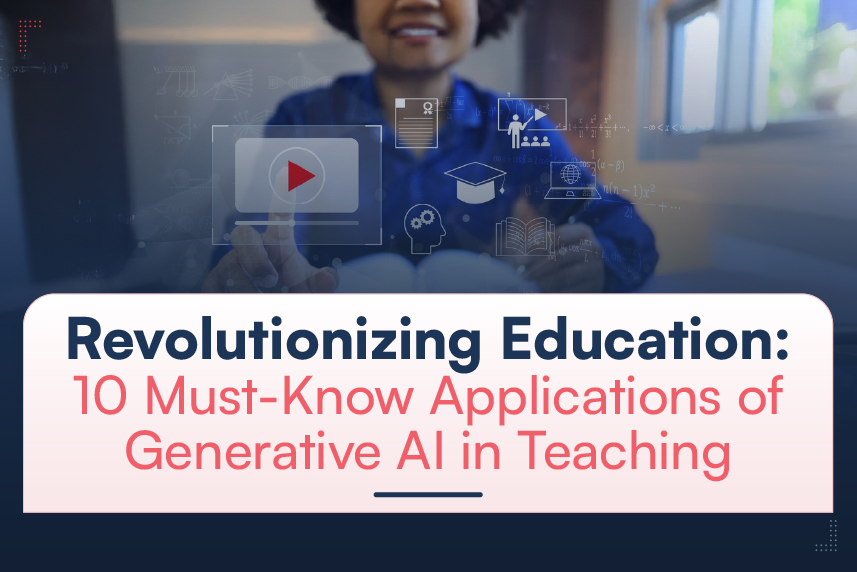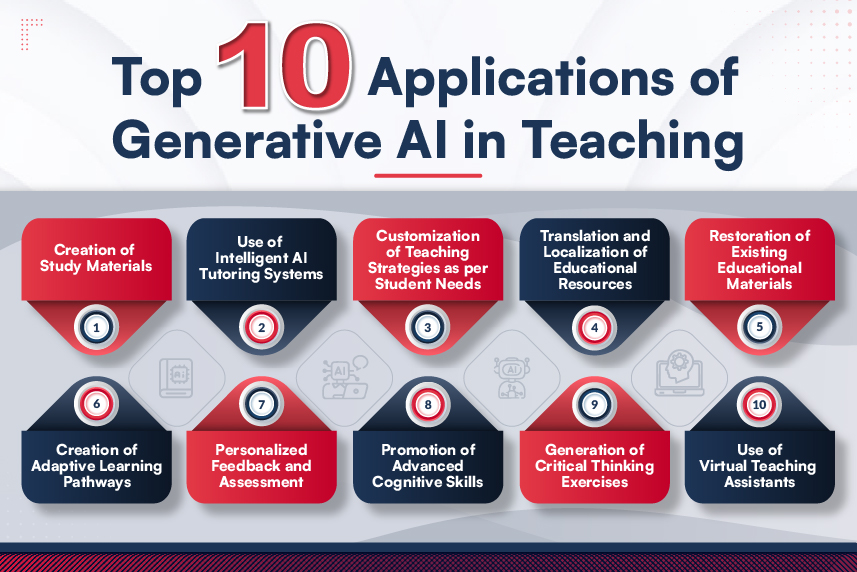
The applications of Generative AI span a vast array of industries, including education, ushering in transformative breakthroughs. They help develop novel solutions and insights previously unimaginable. Generative AI in education is a great opportunity for higher education faculties, student advisors, and school administrators to unlock unprecedented value, experiences, and success.
When it comes to the applications of Generative AI in teaching, they represent a dynamic fusion of state-of-the-art technology and critical teaching elements. In this blog post, you will explore 10 game-changing applications of Generative AI that are shaping teaching in higher education.
The versatile range of the applications of Generative AI is revolutionizing teaching in higher education. Be it personalized content creation, adaptive virtual tutoring, innovative online teaching, or classroom AI applications, Generative AI is poised to transform teaching in higher education for good. Moreover, it promises to enhance student engagement, enable comprehension, improve learning, and drive better student outcomes.
What is Generative AI in Teaching?
Generative AI in teaching is a futuristic technology that harnesses the power of AI to enhance instruction, advance pedagogies, and transform the educational experience. It involves using AI algorithms to create, adapt, and personalize educational content and interactions.
The applications of Generative AI have taken teaching to the next level by enhancing teaching practices, improving instructional outcomes, saving time for faculties, and generating human-like content based on deep learning models. Generative AI in teaching helps:
- Create customized learning materials and assignments.
- Tailor instruction to individual student needs.
- Develop chatbot or virtual tutors to provide real-time support and guidance to students.
- Empower educators to deliver more engaging and effective sessions.
- Create personalized AI-enhanced learning experiences for students.
The rise of Generative AI in education is much expected. With the vast applications of Generative AI in teaching, there is room for limitless innovation in higher education. According to MarketsandMarkets, the AI in education market is projected to grow at a CAGR of 47% between 2018 and 2023. By 2023, the market size is expected to reach $3.68 billion. The virtual facilitators and learning environments application segment could account for the largest market share.
Today, teachers are using Generative AI tools as much as students. A 2023 survey by the Walton Family Foundation and Impact Research revealed 51% of teachers used ChatGPT within two months of its introduction. Contrastingly, only 22% of students used ChatGPT weekly or more. Furthermore, 64% of teachers plan to implement ChatGPT more often.
The use of ChatGPT by students is a hotly contested topic. However, one can’t deny that the various applications of Generative AI in teaching are transforming education. Even when we consider teaching students to responsibly use Generative AI, it can help equip the future workforce with the skills required to supercharge their capabilities and gain success in their professions.
To dig deep and get more clarity on the topic with expert insights, Harbinger recently hosted an interactive Power Hour session on “How Generative AI is Transforming Teaching in Higher Education.” Hosted by Rahul Singh, Senior Director, EdTech, Harbinger Group, the conversation was joined by panelists:
- Dr. Kim William Gordon, EdTech Research Scientist – AI/ALT, EdTech Research Labs
- Michael E. Spencer, Chief Executive Officer, Global Expansion Strategies
- Avinash Lele, President & Chief Growth Officer, Harbinger Group
Top 10 Applications of Generative AI in Teaching

1. Creation of Study Materials
One of the applications of Generative AI in teaching is developing resources like textbooks, worksheets, and interactive learning materials that help teach better and ensure student involvement in higher education. With the help of a large database of educational content and large language models, Generative AI can create educational content based on a given subject, topic, grade level, and other factors.
This AI-generated educational content can supplement traditional learning resources and support teaching in higher education. Additionally, AI-generated educational content can quickly provide newer information to students from different perspectives.
As mentioned earlier, Generative AI is known for its potential to generate human-like content based on various factors and inputs. Considering this potential, Generative AI in education can help effortlessly create brand-new and modified content that supports teaching and learning. Not to forget, Generative AI in curriculum development can prove to be extremely effective and productive for teachers.
2. Use of Intelligent AI Tutoring Systems
As the name suggests, intelligent AI tutoring systems are computer systems engineered to provide immediate and personalized feedback to learners using AI without the need for human intervention.
Recently, intelligent AI tutoring systems have garnered a lot of attention in higher education, given their ability to create personalized, human-like learning experiences. Additionally, AI-generated lesson plans can free the teacher’s time for more productive tasks. This helps ensure students receive education that is tailored to their past performance, learning needs, and skills.
Another advantage of using intelligent AI tutoring systems is the ability to better serve students by teaching them new and different approaches to solve problems. Intelligent AI tutoring systems also promote self-paced learning while tracking the progress of learners and providing them with timely feedback. During student interactions, they take into consideration the learning style, emotions, and other vital factors of students.
3. Customization of Teaching Strategies as per Student Needs
Customization of teaching strategies as per student needs is one of the best applications of Generative AI in education. By leveraging the power of personalized learning with AI, higher education teachers can tailor pedagogies to sync with the unique learning styles, abilities, and progress of individual students.
By analyzing student performance data, AI can recommend specific content, pace, and even interactive exercises to maximize comprehension and learner engagement. This not only enhances learning outcomes but also fosters a more inclusive and adaptable educational environment, ensuring no student is left behind.
4. Translation and Localization of Educational Resources
One of the most interesting applications of Generative AI in education is its ability to support translations to aid the localization of educational resources. In the realm of multilingual learning, AI plays a pivotal role by offering advanced solutions to bridge language barriers.
Additionally, the dominant combination of technologies like natural language processing (NLP), machine learning, and AI can help with translations that are not only accurate but also contextually correct. Furthermore, teachers can provide AI-powered localized educational materials to:
- Ensure better learning and student satisfaction.
- Improve student engagement and retention.
- Ensure high learning performance of students.
- Ensure students easily understand and connect with the educational content.
- Make available culturally relevant educational content.
- Avoid potentially conflicting or culturally sensitive educational content.
- Enhance the learning experience for a broader student audience.
AI enables seamless communication across diverse linguistic backgrounds by leveraging NLP and machine translation. It facilitates automated translation of educational content, ensuring accessibility for students worldwide.
Harbinger’s iTranslate, a Generative AI-powered translation platform, can translate a substantial volume of content in a range of formats (PPT, PDF, Docx, XLF, Video) and 100+ languages. It offers a remarkable translation accuracy rate of 100% for selected languages.
5. Restoration of Existing Educational Materials
Restoration of existing learning materials is one of the most sought-after applications of Generative AI in education. By utilizing deep learning algorithms, Generative AI can breathe new life into outdated or damaged educational content. It can reconstruct missing or degraded portions of texts, images, or videos, effectively preserving valuable resources for future learners.
Moreover, Generative AI in education can improve the quality of digitized materials by upscaling images or converting old formats into modern, more accessible ones. This revitalization process ensures the educational content remains relevant and engaging, contributing to the sustainability and accessibility of knowledge in the ever-evolving landscape of higher education.
6. Creation of Adaptive Learning Pathways
Considered a disruptive technology in higher education, Generative AI plays a vital role in adaptive learning. Customizing educational experiences that align with the unique learning needs of students is one of the top applications of Generative AI in education.
AI algorithms generate personalized learning materials through real-time analysis performance and comprehension. Besides enabling personalized learning with Generative AI, they help modify difficulty levels, formats, and resources to optimize engagement and knowledge retention.
This adaptive approach ensures students advance in their education at their own pace, filling knowledge gaps and challenging them appropriately. Thoughtful applications of Generative AI in education can enhance the effectiveness of adaptive learning systems. This ultimately offers a more customized and efficient educational experience for each student.
7. Personalized Feedback and Assessment
The applications of Generative AI in higher education are many. However, personalized feedback and assessment is one application that has boosted the adoption of Generative AI in teaching and learning. Traditional assessments methods are not capable of delivering real-time feedback, making it difficult for students to measure progress.
On the other hand, Generative AI in education delivers real-time and personalized feedback based on the responses shared by students. It provides instant insights into areas of improvement, helping students identify their strengths and weaknesses.
Additionally, personalized assessments seamlessly adjust the difficulty levels of questions by analyzing student data, ensuring they are challenged appropriately.
Besides personalization, AI helps with automation, accessibility, and gamification in assessments for higher education. Want to learn more about the role of AI in assessments and feedback?
8. Promotion of Advanced Cognitive Skills
Did you know, Generative AI can be used to create challenges to facilitate students to indulge in higher-order thinking skills?
Well, Generative AI can be potentially used to generate challenges to facilitate and enhance skills like evaluation, synthesis, and analysis. These challenges are different knowledge reinforcement tricks; they are designed to encourage students to think out of the box, draw connections, and use these learnings in various situations.
9. Generation of Critical Thinking Exercises
Applications of Generative AI in online education can enhance the critical thinking quotient of students. By analyzing vast datasets, AI can generate diverse and thought-provoking scenarios, puzzles, and questions that challenge the analytical thinking and problem-solving abilities of students.
This fosters critical thinking and fosters curiosity and creativity in students. Ultimately, Generative AI promotes critical thinking ability and prepares learners for complex problem-solving in real-world situations.
10. Use of Virtual Teaching Assistants
The creation of virtual instructors or speech agents in teaching involves the development of AI-powered digital entities capable of delivering educational content and interacting with students in a human-like manner.
These virtual instructors can offer personalized guidance, answer questions, and explain, enhancing the learning experience for students. They are equipped with natural language processing capabilities, enabling them to adapt to the needs of the students and communication styles.
Virtual instructors also facilitate self-paced learning and offer immediate feedback, promoting a deeper understanding of complex concepts. By bridging the gap between human educators and technology, they revolutionize education by providing scalable, accessible, and engaging teaching assistance.
Explore 10 use cases of Generative AI in higher education. Know how our EdTech solutions backed by Harbinger Content Automation APIs can help institutions unlock the true potential of Generative AI in education.
Parting Thoughts
The applications of Generative AI are bringing about a massive change in higher education. Known as the transformative force reshaping education, Generative AI offers a diverse range of applications, from developing personalized study materials to fostering advanced cognitive skills to creating virtual tutors.
As we embrace the era of Generative AI in education, we unlock endless possibilities for enhancing student engagement, comprehension, and overall learning outcomes. The future of education is here – powered by the limitless potential of Generative AI, where teachers use its potential to reduce their workload, simplify administrative tasks, and spend more time interacting with students.
To implement Generative AI in teaching in your higher education system, reach out to our EdTech experts at contact@harbingergroup.com.






